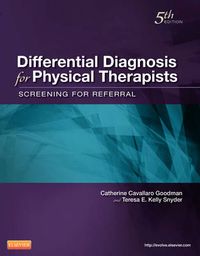
1 säljare
Differential Diagnosis for Physical Therapists Upplaga 5
Written by a leading expert in the field, this comprehensive reference text enables users to properly screen for medical disease to make an informed differential diagnosis. The goal of this text is to teach the Physical Therapist how to determine if the patient has a true neuromuscular or musculoskeletal problem and to determine the specific dysfunction or impairment. This new edition includes a chapter that focuses specifically on pain. It also contains a new chapter on physical assessment as a screening tool and the introductory chapter has been revised to explain the more modern approach of screening.5-Step screening model for differential diagnosis includes past medical history, risk factor assessment, clinical presentation, associated signs and symptoms, and review of symptoms. Systems-based approach to the physical therapy screening interview provides a consistent way to screen for systemic disease and medical conditions that can mimic neuromuscular and musculoskeletal problems.Three sections of content present material in a logical way that covers: An introduction to the screening processViscerogenic causes of neuromusculoskeletal pain and dysfunctionSystem origins of neuromusculoskeletal pain and dysfunctionCognitive processing and reasoning orientation approach encourages you to gather and analyze data, pose and solve problems, infer, hypothesize, and make clinical judgments.Case examples and case studies give real-world examples of hot to integrate screening information into the diagnosis process.Screening tools in the book and on the Evolve companion website feature forms and checklists used in professional practice.Introductory information on medical screening concepts set the stage for how screening is presented in the rest of the book.Reference values for common clinical laboratory tests offer easy access to pertinent information references in a screening exam.Red flag histories, risk factors, clinical presentation, signs and symptoms, helpful screening clues, and guidelines for referral bring your attention to the important information a therapist needs to be aware of during the screening process.NEW! Full-color design, photos, and illustrations clearly demonstrate pathologies and processes.NEW and UPDATED! Evolve resources include printable screening tools and checklists, practice test questions, and more to enhance your learning.NEW! Hot topics keep you informed on rehabbing patients in the dawn or more current surgeries.
Upplaga: 5e upplagan
Utgiven: 2012
ISBN: 9781437725438
Förlag: W B Saunders Co Ltd
Format: Häftad
Språk: Engelska
Sidor: 816 st
Written by a leading expert in the field, this comprehensive reference text enables users to properly screen for medical disease to make an informed differential diagnosis. The goal of this text is to teach the Physical Therapist how to determine if the patient has a true neuromuscular or musculoskeletal problem and to determine the specific dysfunction or impairment. This new edition includes a chapter that focuses specifically on pain. It also contains a new chapter on physical assessment as a screening tool and the introductory chapter has been revised to explain the more modern approach of screening.5-Step screening model for differential diagnosis includes past medical history, risk factor assessment, clinical presentation, associated signs and symptoms, and review of symptoms. Systems-based approach to the physical therapy screening interview provides a consistent way to screen for systemic disease and medical conditions that can mimic neuromuscular and musculoskeletal problems.Three sections of content present material in a logical way that covers: An introduction to the screening processViscerogenic causes of neuromusculoskeletal pain and dysfunctionSystem origins of neuromusculoskeletal pain and dysfunctionCognitive processing and reasoning orientation approach encourages you to gather and analyze data, pose and solve problems, infer, hypothesize, and make clinical judgments.Case examples and case studies give real-world examples of hot to integrate screening information into the diagnosis process.Screening tools in the book and on the Evolve companion website feature forms and checklists used in professional practice.Introductory information on medical screening concepts set the stage for how screening is presented in the rest of the book.Reference values for common clinical laboratory tests offer easy access to pertinent information references in a screening exam.Red flag histories, risk factors, clinical presentation, signs and symptoms, helpful screening clues, and guidelines for referral bring your attention to the important information a therapist needs to be aware of during the screening process.NEW! Full-color design, photos, and illustrations clearly demonstrate pathologies and processes.NEW and UPDATED! Evolve resources include printable screening tools and checklists, practice test questions, and more to enhance your learning.NEW! Hot topics keep you informed on rehabbing patients in the dawn or more current surgeries.
Begagnad bok
699 kr
Fri frakt & skickas inom 1-3 vardagar
Köpskydd med Studentapan
Varje köp täcks av Studentapans köpskydd som säkerställer att boken kommer fram, att du får rätt bok och att skicket stämmer överens med beskrivning.



